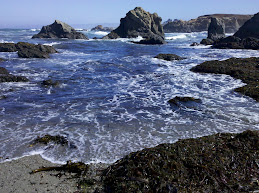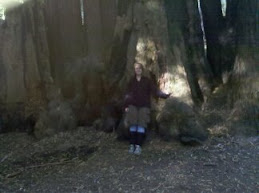We live at a time when the economy, energy and the environment are all giving us clear reminders that we live on a finite planet, with finite resources. Our economy is based on a model of continuous growth which is clearly unsustainable—just think of a cancer cell. Our energy is overwhelmingly based on petroleum which is a non-renewable energy source that is nearing if not surpassing peak production. And our environment is showing great signs of stress and injury as we pursue both endless economic growth and oil energy.
Change is upon us. Whether we like it or not, we will have to live with the physical consequences that our current system has created. We can continue with the status quo—denying anything is wrong and continuing to live resource intensively. Or we can start the work of transforming our society into an integrated, holistic, sustainable whole. I believe this is the challenge of our time.
And I believe that magic—in the pagan, witchcraft sense—has much to offer for helping us achieve this transformation. Because the principles of magic are rooted in psychology and are in tune with the findings of neuroscience and physics, they can provide valuable tools for both the inner transformation and community transformation needed to successfully transition to a healthier world.
Much of my understanding of Magic and Witchcraft comes from the writings of Starhawk, and from her book The Spiral Dance in particular. When I first read this book I was surprised. I had read many spirituality books, and all of them had some great little nuggets of wisdom or information, but all of them also had parts that I could not agree with. Starhawk’s book was different. In reading a book on magic, I had expected to hear arguments about why I should believe in the Goddess and Magic, but instead she presents the idea of manifest deity:
“People often ask me if I believe in the Goddess. I reply, “Do you believe in rocks?”… In the Craft we do not believe in the Goddess—we connect with Her; through the moon, the stars, the ocean, the earth, through trees, animals, through other human beings, through ourselves. She is here. She is within us all. She is the full circle: earth, air, fire, water, and essence—body, mind, spirit, emotions, change” (91-92).
Basically, she is saying that the word “Goddess” is just a short cut way of describing everything that we can see and touch and feel and hear. I may not be comfortable with the specific words used, but this concept fit with both my spiritual sensibilities and with my scientific mind.
I had also expected to be told what to do and how to do it. Instead, Starhawk presents suggestions for rituals and spells, but specifically says that what is really important is finding what works for me. In talking about the tools of Magic, Starhawk says, “The mind works magic, and no elaborately forged knife or elegant wand can do any more than augment the power of a trained mind. The tools are simply aids in communicating with Younger Self, who responds much better to tangibles than to abstracts” (75).
Which leads me to where Magic and Psychology intersect. Starhawk says, “Learning to work magic is a process of neurological repatterning, of changing the way we use our brains…” (123). This fits in exactly with information from the different fields of brain research. I love reading about brains. It is fascinating to learn how the different parts of the brain work, the role that biochemistry plays, and how the environment impacts our brains.
One of my favorite brain books is My Stroke of Insight by neuroanatomist Jill Bolte Taylor. This book describes her experience of having a stroke and how she fully recovered. Because of her work as a neuroanatomist, she knew the exact science of what was happening in her brain as the stroke was occurring. However, the actual experience gave her huge insights into how our brains really function and just what they are capable of.
Jill’s stroke was in the left hemisphere, which is the half of the brain responsible for linear, logical, linguistic thinking. The right side of our brains is nonlinear, holistic and visuo-spatially oriented. On the morning of the stroke, Jill’s left brain stopped and started working over and over again. When it was working, she knew that she was having a stroke, and knew that she needed help. When her left brain shut down, she could no longer track her experience or make a plan. Because of this, it took her several hours to successfully call for help.
Jill says, “I remember that first day of the stroke with terrific bitter-sweetness. In the absence of the normal functioning of my left orientation association area, my perception of my physical boundaries was no longer limited to where my skin met air. I felt like a genie liberated from its bottle. The energy of my spirit seemed to flow like a great whale gliding through a sea of silent euphoria” (67).
With her left brain silenced, Jill was able to experience a oneness with the universe, a sense of detachment to the things of the ego, and an all encompassing peace and compassion. One of the main points in her book is that, in this society, we spend too much time in our left brain, and not enough time in our right, and that the world would be a much more peaceful place if we balanced this out.
This fits with what Starhawk says about magic. She says that rituals and spell casting are just ways of tapping into and evoking our right brain—the part she calls “Younger Self.” She says that we put on flowing capes and light candles and dance to drum music not because there is something inherently magical about those things, but because our right brain responds to play and fun and pleasure. This is why she says that you have to find rituals and tools that work for you—what is play for me might not be play for you. My right brain may respond well to moonlight dancing, while yours might respond best to biking through the park. Because our right brains are holistic, the best way to tap into them is by tapping into our senses—what we see, hear, taste, touch and smell.
Which brings us back to manifest deity—Goddess, God, the Great Mystery—is all found in things that we directly experience. It is not found in logical, left brain abstractions, but in our right brain experience of wholeness and interconnection. I believe that it is a balance between these two halves of our brain that enables us to be fully human.
I want to talk a little about physics now. I have little formal education in the hard sciences, but I greatly enjoy reading about the different hard science fields. I have been told that there is no way to give a truly precise explanation of physics without mathematics. Most of us don’t speak mathematics, so we have to settle for the less precise explanations found in words. So here is what I understand of quantum mechanics: All things are made up of both matter and energy. Energy is always moving, and is not contained by matter. I like the explanation that mathematical cosmologist Brian Swimme gives in his book The Universe is a Green Dragon. In this book he translates his knowledge of cosmology and physics into a poetically accessible story. Here is how he explains this concept:
“When you look at the moon, you are absorbing the moon just as the ocean absorbs minerals.
In terms of quantum mechanics, you as an individual body are represented by a particular quantum state. This includes the interactions of all the elementary particles of your body. Now imagine a patterned wave of light flowing into you. Some of the photons of this light wave interact with your own elementary particles, and through this interaction your quantum state is changed… Your particles are new in the sense that they have absorbed something from the photons and entered a new state of being.
This means that when you stand in the presence of the moon, you become a new creation. The photon’s interactions have entered into the quantum state of your entire ensemble and you are, through these interactions, a moon-person… The elementary particles of your body have absorbed an influence and in that sense they—and you—are brand, spanking new, a human being resonating everywhere with moonlight.”
Research on the transfer of energy between humans—which is a given in quantum physics—is still relatively new, but it fits with the experiences most of us have had in our own lives. Haven’t you ever been around someone who drained your energy? Or haven’t you felt disproportionately energized after being around a particularly optomistic friend? The work of Jan Fowler and Nicholas Christakis of Harvard University in 2008 reveals that happiness might be contagious. This aspect of physics—that we are constantly interchanging energy with the world around us—supports the idea that we can affect the world beyond our own skin by affecting the energy flowing through us and between us.
Which brings me back to Magic. One of the definitions of magic is “the art of changing consciousness at will.” Starhawk says, “Magic requires first the development and then the integration of right-hemisphere, spatial, intuitive, holistic, patterning awareness. It opens the gates between the unconscious and the conscious minds.”
In other words, you cast a spell to align your mind, body and spirit with your will, and through your will, you work to obtain what you desire. So, if you need a job, you cast a spell for a job in order to align your mind, body and spirit with the idea of a manifesting a new job. And then you go out and do some serious job hunting—search the want ads, fill out applications, send in resumes and so on. Magic in our world is not the instant gratification Harry Potter magic. It is not enough to wish that something were so—you have to do both inner work and outer work.
Why not skip the spell and just do the job hunting? There is scientific research that shows that doing both increases your chances of being successful. For example, in 2010, one of the scientific projects reported in the publication The Week showed that people who had a lucky charm and who believed in that lucky charm set higher goals and felt more confident.
You can say that this is the placebo affect, but I think the placebo affect proves just how incredibly powerful our minds are. Think about it—you take a sugar pill and, by the power of your mind alone, you make yourself heal. That’s pretty powerful. Witchcraft believes in the power of our minds and works to harness that power to our benefit and the benefit of our world.
This is why I say that Magic has much to offer us in the challenges we face today—with our economy, energy, and environment all showing signs of crashing up against the realities of physical limitations—we need to develop a clear and strong vision of a healthier, happier, sustainable world. And then we need to engage our senses, tap into Younger Self with pleasure and play in order to harness our own inner energies and align our wills with our vision in order to manifest that vision.
Blessed Be.
Tuesday, February 1, 2011
Subscribe to:
Post Comments (Atom)



No comments:
Post a Comment